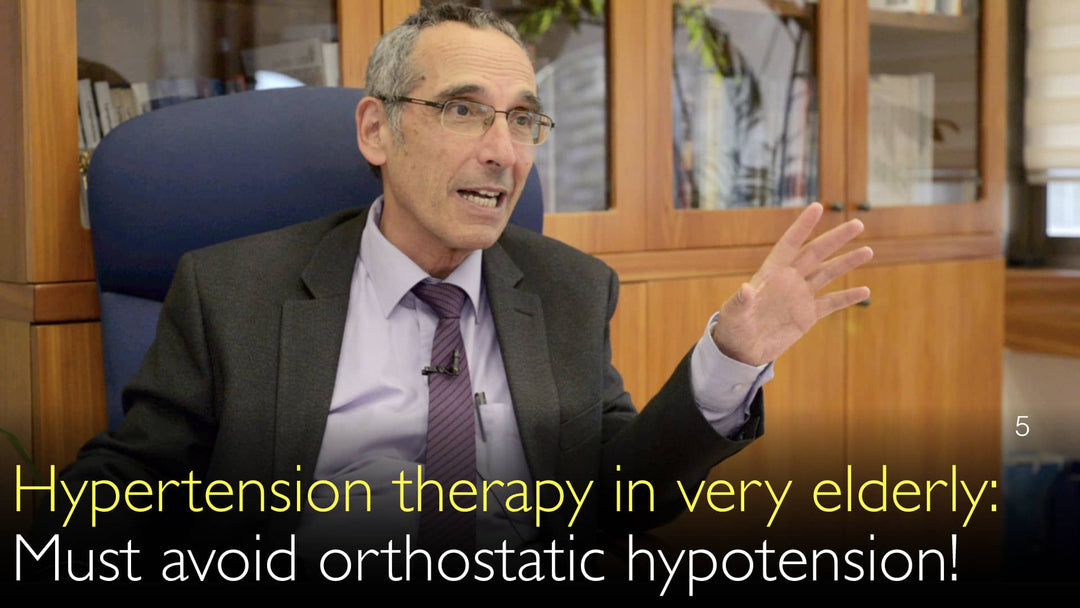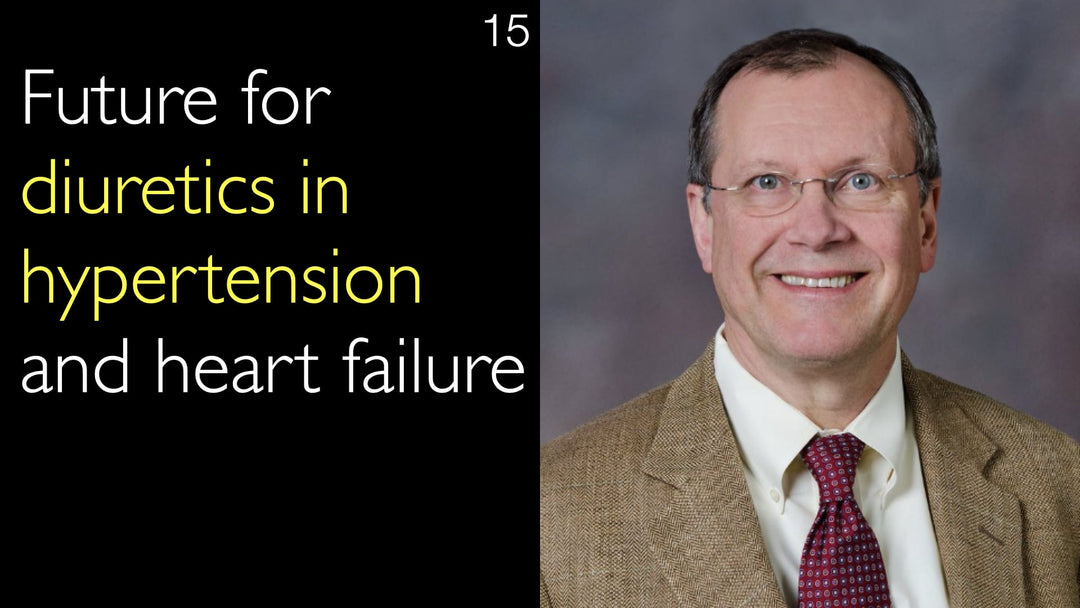Leading expert in hypertension therapy, Dr. Ehud Grossman, MD, explains the critical nuances of treating high blood pressure in very elderly patients. He details the significant risks of orthostatic hypotension and cerebral hypoperfusion. Dr. Ehud Grossman, MD, emphasizes a cautious, gradual treatment approach with lower initial medication doses. He strongly advises checking blood pressure in both sitting and standing positions during treatment adjustments. This strategy balances long-term cardiovascular protection against immediate risks of falls and injury.
Managing High Blood Pressure in Older Adults: Preventing Dizziness and Falls
Jump To Section
- Elderly Hypertension Treatment Nuances
- Orthostatic Hypotension Risks
- Blood Pressure Goals for the Elderly
- Safe Medication Adjustment Strategy
- Sitting and Standing BP Measurement Protocol
- Full Transcript
Elderly Hypertension Treatment Nuances
Treating hypertension in very elderly patients requires a specialized approach. Dr. Ehud Grossman, MD, defines this patient group as individuals over 70 or 80 years of age. He clarifies that the patient's overall condition and functional status are more critical than chronological age alone. The primary concern is their heightened sensitivity to blood pressure-lowering effects.
Dr. Ehud Grossman, MD, explains that cerebral blood flow is highly dependent on systemic blood pressure in older adults. An aggressive reduction can lead to decreased brain perfusion. This hypoperfusion can potentially cause neurological damage. The interview with Dr. Anton Titov, MD, highlights the need for a holistic view of each patient's health.
Orthostatic Hypotension Risks
Orthostatic hypotension presents a major risk during hypertension treatment in the elderly. Dr. Ehud Grossman, MD, describes this as a significant drop in blood pressure upon standing. A patient might have a controlled sitting pressure of 140/80 mmHg. But upon standing, their systolic pressure could plummet to 80 or 90 mmHg.
This sudden drop can cause fainting, leading to serious injuries like fractures. Dr. Ehud Grossman, MD, notes that the immediate danger of a fall often outweighs the long-term benefit of stroke prevention. This risk-benefit analysis is central to safe hypertension management in frail patients.
Blood Pressure Goals for the Elderly
Blood pressure targets are often set higher for very elderly patients compared to younger individuals. Dr. Grossman advocates for this more lenient approach to avoid complications. The goal is to achieve protection from long-term issues like stroke and heart failure without causing acute harm.
A key metric is the change in pressure from sitting to standing. A drop of 5-10 mmHg in systolic pressure is considered acceptable. However, a decrease of 20 mmHg systolic or 10 mmHg diastolic defines orthostatic hypotension. This condition requires immediate intervention through medication adjustment.
Safe Medication Adjustment Strategy
A gradual, cautious medication strategy is essential for elderly hypertension patients. Dr. Ehud Grossman, MD, advises starting with lower doses than those used for younger adults. Dose adjustments must be made slowly over time to prevent a sudden, dangerous fall in blood pressure.
Dr. Ehud Grossman, MD, states that reaching the optimal blood pressure target may take several weeks or even months. This slow titration is the opposite of a more aggressive approach suitable for younger, healthier patients. The conversation with Dr. Anton Titov, MD, underscores that patience is a virtue in geriatric hypertension care.
Sitting and Standing BP Measurement Protocol
Routine blood pressure measurement in both positions is a critical safety practice. Dr. Grossman emphatically states that clinicians must check pressure while the patient is sitting and standing. This is especially important when initiating a new antihypertensive medication or changing its dose.
If no significant difference is found initially, repeated standing measurements may not be necessary. However, any alteration to the treatment regimen mandates re-checking in both positions. This protocol directly monitors for the orthostatic hypotension side effect that some medications can induce. Dr. Anton Titov, MD, and Dr. Ehud Grossman, MD, agree this simple step is vital for patient safety.
Full Transcript
Dr. Ehud Grossman, MD: "Very elderly" age is defined as over 70 or 80 years of age. What are the nuances of treating hypertension in the very elderly age group? Those who are over 70 or 80 years old—the point is not the age but the patient's condition. You see how active the patient is and what he is able to do.
The main point that I find in the elderly is that they are very sensitive to lowering blood pressure because the blood flow to the brain depends on the blood pressure. Sometimes when you lower the blood pressure too much, you get less perfusion to the brain, and it may cause some damage.
Second, elderly patients are more susceptible to what we call orthostatic hypotension, where the blood pressure falls when they stand up. If you lower the blood pressure and control it to 140/80 when the patient is sitting, and then when the patient stands up, his blood pressure falls to 80–90 systolic, he may faint. So the elderly are more fragile, and you have to be more careful.
First, we agree that the blood pressure target may be a little bit higher than in young subjects. We have to see the whole picture of the patient—it's not only the age but always the function and what additional diseases the patient has. We have to start with lower doses and adjust the dose gradually to prevent too much fall in blood pressure, which is even more risky.
When you lower the blood pressure, you prevent in the long run stroke and congestive heart failure. But if the price that the patient pays is that his blood pressure falls immediately and he faints and breaks his leg, then the immediate risk is much higher than the benefit of long-term prevention of disease. So you have to balance and see what you have—what is the risk of acute side effects, etc.
In the elderly, you go slowly until you reach the blood pressure treatment target, and it may take several weeks or even months. Unlike in young subjects, where you can go more aggressively in the adjustment of medications and doses of hypertension medications.
Dr. Anton Titov, MD: Does that mean that it makes sense for elderly people, especially depending on their functional status, to measure arterial blood pressure when they're in a standing position?
Dr. Ehud Grossman, MD: Definitely, the answer is yes. You have to take the blood pressure when you are sitting and when you are standing. If, the first time that you do it, there is no difference between sitting and standing blood pressure values, then you don't have to do it again.
But when you start anti-hypertension medications, and every time you change the dose, you have to do it again because some of the side effects of the drugs are orthostatic hypotension. So if you start with a normal response, but then when you give a new type of medication, the blood pressure might fall too much when you stand.
Every time you change the dose or the medication, you have to check the blood pressure while sitting and while standing.
Dr. Anton Titov, MD: What would be the correct goal of blood pressure lowering in the standing position?
Dr. Ehud Grossman, MD: The blood pressure goal in the standing position is the same as in the sitting position, which means not lower than 10 millimeters from the sitting position. If the systolic blood pressure decreased by 20 millimeters of mercury while moving from the sitting to the standing position, we call it an orthostatic response, and it may be a problem.
So we measure the blood pressure—a difference of 5 to 10 mm of mercury is acceptable. If it's 20 millimeters of mercury in the systolic blood pressure or 10 millimeters of mercury in the diastolic blood pressure, this is orthostatic hypotension, and we try to prevent it because it may cause damage.
Dr. Anton Titov, MD: By adjusting doses of medications or changing medications?
Dr. Ehud Grossman, MD: Right!








